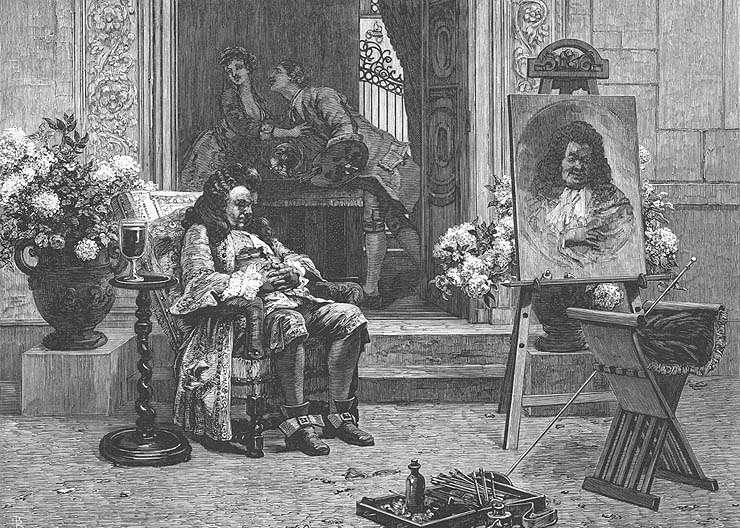|
THE PAINTER'S REPOSE
Artist: J. G. Vibert ____________ Engraver: Unknown |
 Note: the title in the table above is printed below the engraving
Note: the title in the table above is printed below the engraving
CLICK HERE TO SEE MORE OLD WORLD VIEWS LIKE THIS ONE!!
AN ANTIQUE WOOD ENGRAVING MADE IN THE LATE 1870s!!
FROM THE ORIGINAL DESCRIPTION: We give on page 279 an engraving, executed by W. J. Linton, of Vibert's painting, exhibited in the last Paris Salon under the title of 'Le Repos du Peintre.' The reader will probably recollect a description of this painting given by our Paris correspondent in the March number of the Art Journal, who saw it in Vibert's studio. Our correspondent's description of the story of the painting we need not here reproduce, inasmuch as the engraving tells this sufficiently well. It is clearly seen that, during an interval of rest of the painter, the fat and pompous-looking burgomaster, whose portrait is in process, has fallen asleep, and the painter has taken advantage of this incident to enjoy a flirtation with a pretty little soubrette who is bringing- a tray of refreshments upon the scene. "The delicate finish, "wrote our correspondent, "and minute manipulations, which are characteristics of Vibert's work, have been lavished upon this amusing little picture. The embroidery on the burgomaster's vest, the carvings of the stonework, &c., are all admirably executed, as is also the fat, red face of the drowsy sitter, flushed, and swollen, and pompous, even in sleep."
BIOGRAPHY OF ARTIST: Jehan Georges Vibert was born on September 30th , 1840 in France. In his early years he was trained under Barrias and on April 4th, 1857, entered the Ecole des Beaux Arts. During the early part of his career he painted rather serious and dramatic subjects, such as "The Death of Narcissus" and "Christian Martyrs in the Lion pit." He entered the Salon in 1863; found his first success with a medal at the 1864 salon, and won a financial prize at the universal exposition of 1867. Around 1867, however, his style changed and instead of the dramatic and serious, he started painting "small things and niggling." Instead of heroic Christians and tragic mythology, he turned to more homey subjects such as The Barber of Ambulart. In 1870, while Paris was under siege to the Prussians, Vibert fought and was wounded at the battle of Malmaison. His courage, though, earned him the honor of being made a Knight of the Legion of Honor. Though he was himself a hero, his growing attraction to the less serious subjects of genre did not ebb. Instead, it was stimulated by his interests in comedy and satire. Not only did he enjoy taking a break from work to go out to plays, but he also wrote several comedies, many of which were successfully produced at Paris theaters such as the Vaudeville. As well as from his own comedies, he gathered subject matter from the French fabulist Lafontaine (of whom he had a bust in his house) and the satirist Jonathan Swift.
In 1878 he achieved his first popular success with a huge history painting. "The Apotheosis of Mr. Thiers" was the talk of Paris even before it was completed. However, in spite of the success of this painting, he would spend most of his creative time on the humorous scenes that he enjoyed. During the later part of his life, his interest turned to the clergy. Paintings such as The Fortune Teller, The Diet, and Monk picking radishes satirized the clergy's irreligious indulgences or depicted them in homey situations to an audience used to seeing the church ennobled in traditional religious and historic works. These would be the paintings that would make his reputation. In 1882, he was promoted to Officer of the Legion of Honor, for his painting this time. This growing reputation would make him one the the most sought after atelier masters at the Ecole des Beaux Arts. This would lead him to being one of the seven most influential artists of his time, along with Bouguereau, Cabanel, Meissonnier, Gérôme, Bonnat, and Lefebvre. He died suddenly of heart disease on July 28th 1902.
PRINT DATE: This lithograph was printed in the 1870s; it is not a modern reproduction in any way.
PRINT SIZE: Overall print size is 9 inches by 12 inches including white borders (not shown), actual scene is 7 inches by 10 inches.
PRINT CONDITION: Condition is fine. Bright and clean. There is text on the reverse side as this print was extracted from an old art journal, but the text does not show through.
SHIPPING:Buyers to pay shipping/handling, domestic orders receives priority mail, international orders receive regular mail.
We pack properly to protect your item!
Please note: the terms used in our auctions for engraving, heliogravure, lithograph, print, plate, photogravure etc. are ALL prints on paper, NOT blocks of steel or wood. "ENGRAVINGS", the term commonly used for these paper prints, were the most common method in the 1700s and 1800s for illustrating old books, and these paper prints or "engravings" were inserted into the book with a tissue guard frontis, usually on much thicker quality rag stock paper, although many were also printed and issued as loose stand alone prints. So this auction is for an antique paper print(s), probably from an old book, of very high quality and usually on very thick rag stock paper.
EXTREMELY RARE IN THIS EXCELLENT CONDITION!
|
